fuel pressure DODGE CHALLENGER 2011 3.G Owners Manual
[x] Cancel search | Manufacturer: DODGE, Model Year: 2011, Model line: CHALLENGER, Model: DODGE CHALLENGER 2011 3.GPages: 490, PDF Size: 6.22 MB
Page 86 of 490
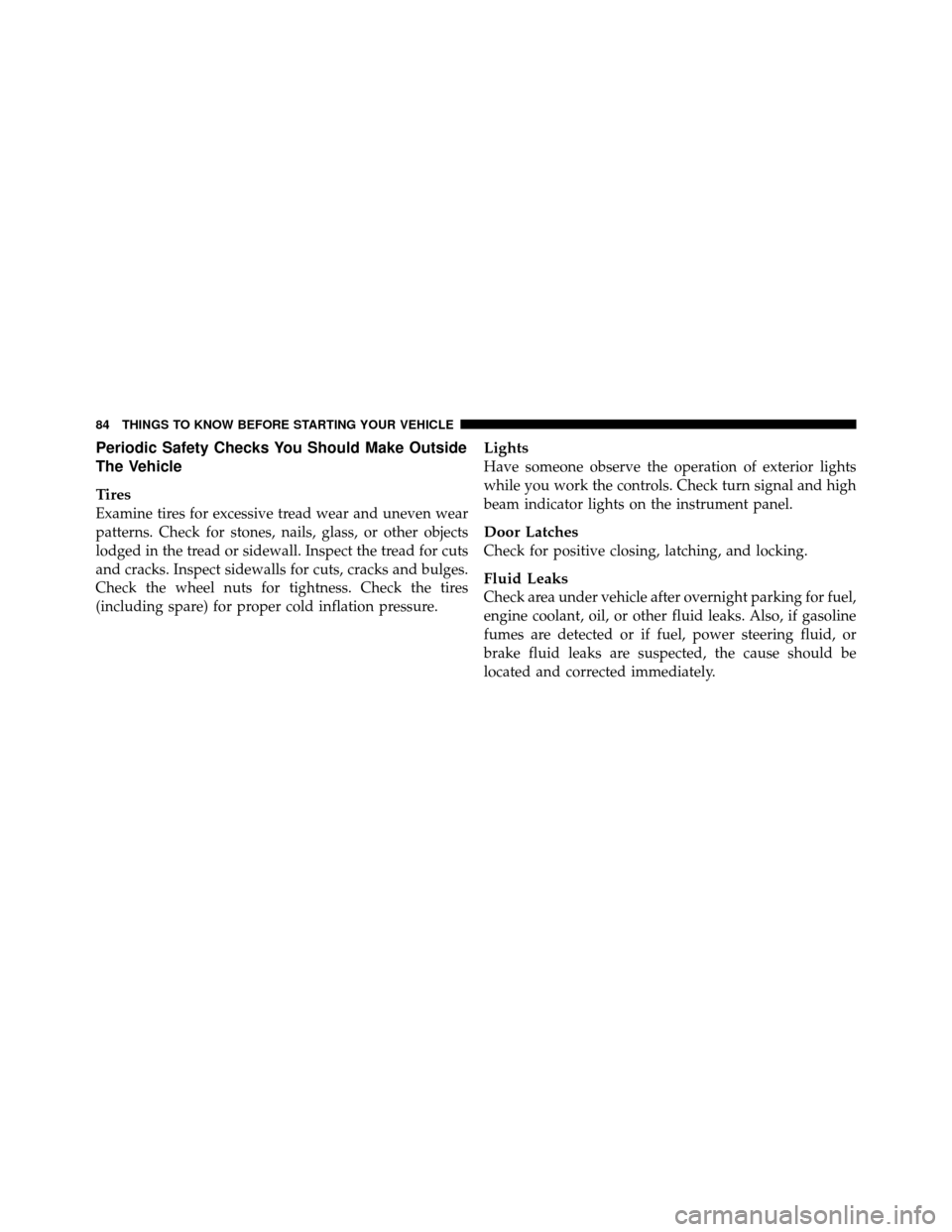
Periodic Safety Checks You Should Make Outside
The Vehicle
Tires
Examine tires for excessive tread wear and uneven wear
patterns. Check for stones, nails, glass, or other objects
lodged in the tread or sidewall. Inspect the tread for cuts
and cracks. Inspect sidewalls for cuts, cracks and bulges.
Check the wheel nuts for tightness. Check the tires
(including spare) for proper cold inflation pressure.
Lights
Have someone observe the operation of exterior lights
while you work the controls. Check turn signal and high
beam indicator lights on the instrument panel.
Door Latches
Check for positive closing, latching, and locking.
Fluid Leaks
Check area under vehicle after overnight parking for fuel,
engine coolant, oil, or other fluid leaks. Also, if gasoline
fumes are detected or if fuel, power steering fluid, or
brake fluid leaks are suspected, the cause should be
located and corrected immediately.
84 THINGS TO KNOW BEFORE STARTING YOUR VEHICLE
Page 187 of 490
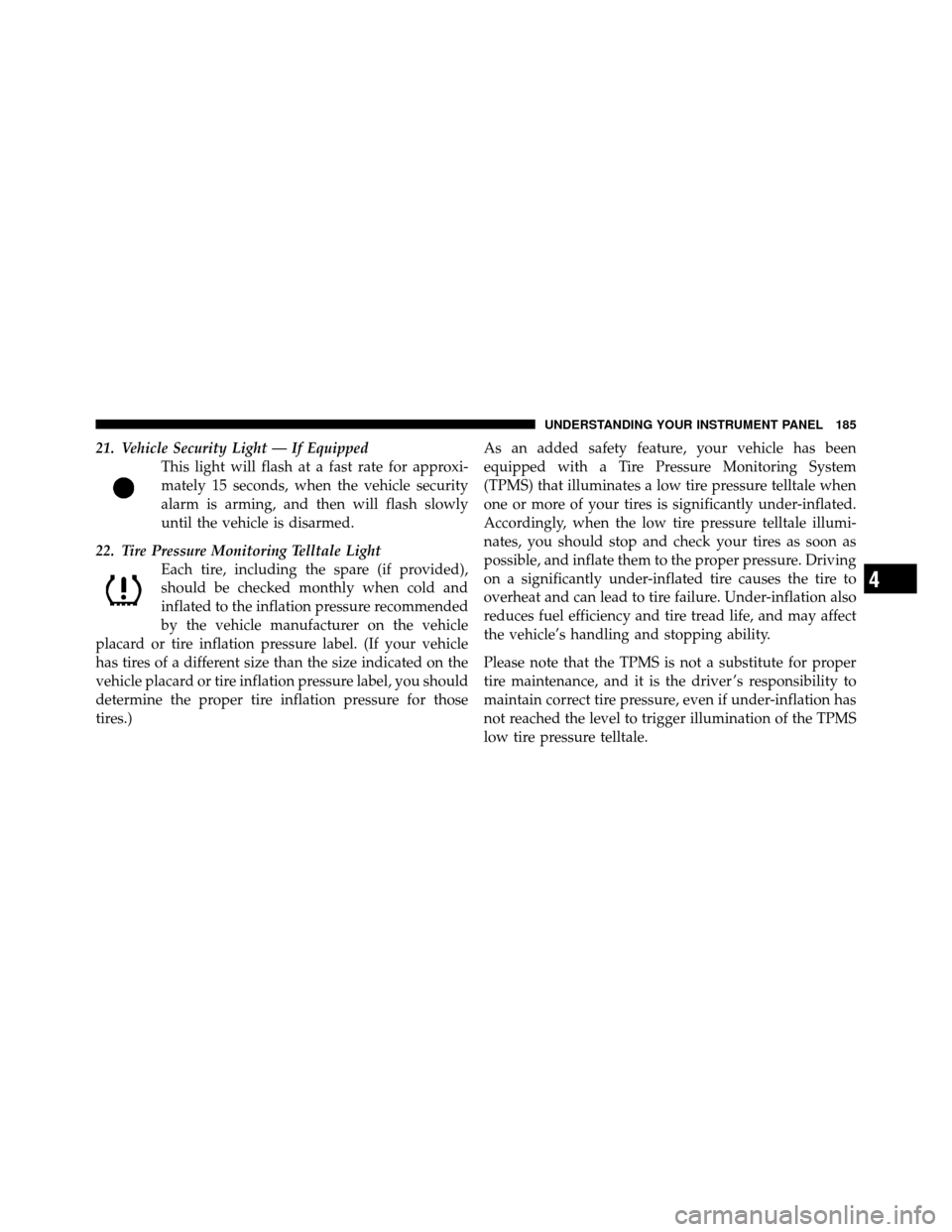
21. Vehicle Security Light — If EquippedThis light will flash at a fast rate for approxi-
mately 15 seconds, when the vehicle security
alarm is arming, and then will flash slowly
until the vehicle is disarmed.
22. Tire Pressure Monitoring Telltale Light Each tire, including the spare (if provided),
should be checked monthly when cold and
inflated to the inflation pressure recommended
by the vehicle manufacturer on the vehicle
placard or tire inflation pressure label. (If your vehicle
has tires of a different size than the size indicated on the
vehicle placard or tire inflation pressure label, you should
determine the proper tire inflation pressure for those
tires.) As an added safety feature, your vehicle has been
equipped with a Tire Pressure Monitoring System
(TPMS) that illuminates a low tire pressure telltale when
one or more of your tires is significantly under-inflated.
Accordingly, when the low tire pressure telltale illumi-
nates, you should stop and check your tires as soon as
possible, and inflate them to the proper pressure. Driving
on a significantly under-inflated tire causes the tire to
overheat and can lead to tire failure. Under-inflation also
reduces fuel efficiency and tire tread life, and may affect
the vehicle’s handling and stopping ability.
Please note that the TPMS is not a substitute for proper
tire maintenance, and it is the driver ’s responsibility to
maintain correct tire pressure, even if under-inflation has
not reached the level to trigger illumination of the TPMS
low tire pressure telltale.
4
UNDERSTANDING YOUR INSTRUMENT PANEL 185
Page 193 of 490
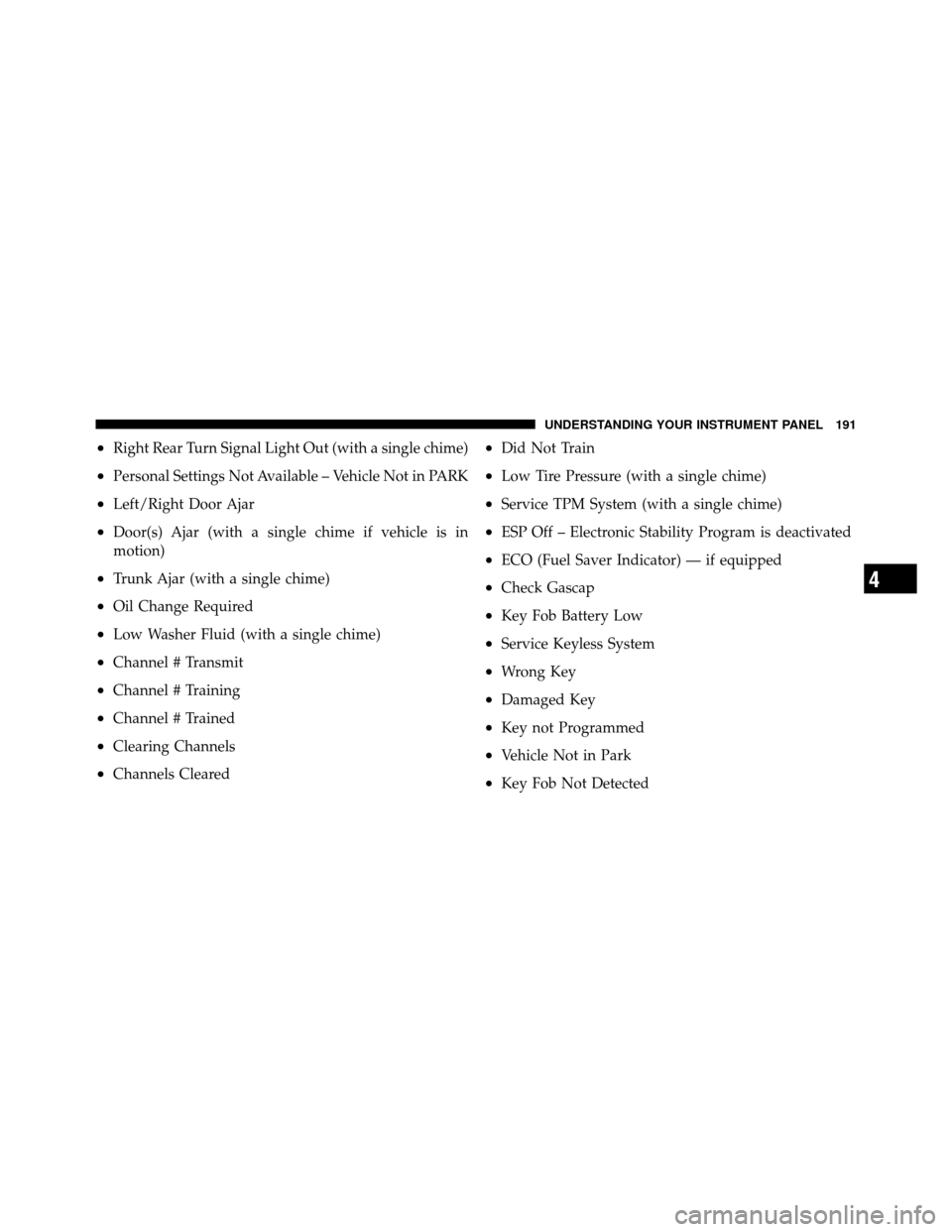
•Right Rear Turn Signal Light Out (with a single chime)
•Personal Settings Not Available – Vehicle Not in PARK
•Left/Right Door Ajar
•Door(s) Ajar (with a single chime if vehicle is in
motion)
•Trunk Ajar (with a single chime)
•Oil Change Required
•Low Washer Fluid (with a single chime)
•Channel # Transmit
•Channel # Training
•Channel # Trained
•Clearing Channels
•Channels Cleared
•Did Not Train
•Low Tire Pressure (with a single chime)
•Service TPM System (with a single chime)
•ESP Off – Electronic Stability Program is deactivated
•ECO (Fuel Saver Indicator) — if equipped
•Check Gascap
•Key Fob Battery Low
•Service Keyless System
•Wrong Key
•Damaged Key
•Key not Programmed
•Vehicle Not in Park
•Key Fob Not Detected
4
UNDERSTANDING YOUR INSTRUMENT PANEL 191
Page 303 of 490
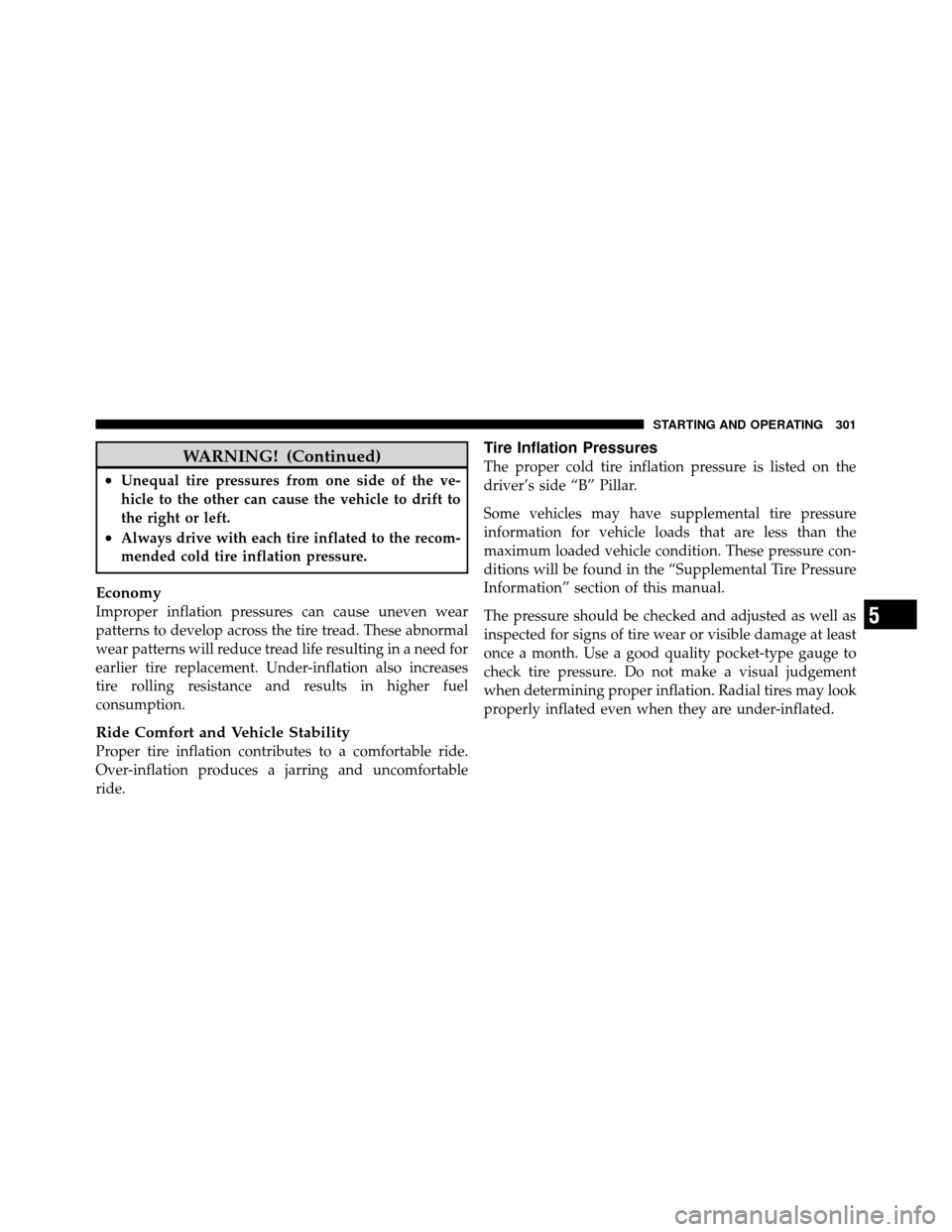
WARNING! (Continued)
•Unequal tire pressures from one side of the ve-
hicle to the other can cause the vehicle to drift to
the right or left.
•Always drive with each tire inflated to the recom-
mended cold tire inflation pressure.
Economy
Improper inflation pressures can cause uneven wear
patterns to develop across the tire tread. These abnormal
wear patterns will reduce tread life resulting in a need for
earlier tire replacement. Under-inflation also increases
tire rolling resistance and results in higher fuel
consumption.
Ride Comfort and Vehicle Stability
Proper tire inflation contributes to a comfortable ride.
Over-inflation produces a jarring and uncomfortable
ride.
Tire Inflation Pressures
The proper cold tire inflation pressure is listed on the
driver’s side “B” Pillar.
Some vehicles may have supplemental tire pressure
information for vehicle loads that are less than the
maximum loaded vehicle condition. These pressure con-
ditions will be found in the “Supplemental Tire Pressure
Information” section of this manual.
The pressure should be checked and adjusted as well as
inspected for signs of tire wear or visible damage at least
once a month. Use a good quality pocket-type gauge to
check tire pressure. Do not make a visual judgement
when determining proper inflation. Radial tires may look
properly inflated even when they are under-inflated.
5
STARTING AND OPERATING 301
Page 316 of 490
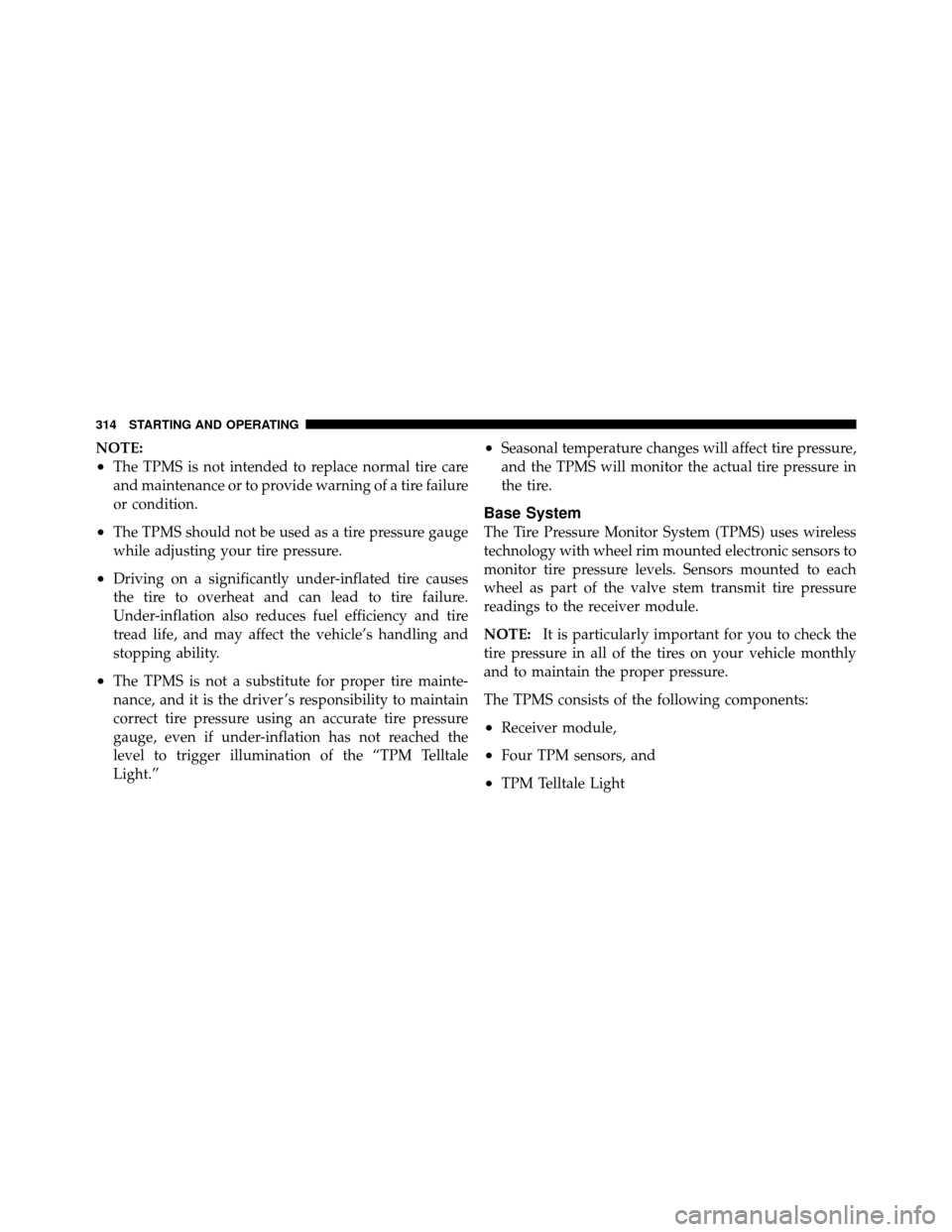
NOTE:
•The TPMS is not intended to replace normal tire care
and maintenance or to provide warning of a tire failure
or condition.
•The TPMS should not be used as a tire pressure gauge
while adjusting your tire pressure.
•Driving on a significantly under-inflated tire causes
the tire to overheat and can lead to tire failure.
Under-inflation also reduces fuel efficiency and tire
tread life, and may affect the vehicle’s handling and
stopping ability.
•The TPMS is not a substitute for proper tire mainte-
nance, and it is the driver ’s responsibility to maintain
correct tire pressure using an accurate tire pressure
gauge, even if under-inflation has not reached the
level to trigger illumination of the “TPM Telltale
Light.”
•Seasonal temperature changes will affect tire pressure,
and the TPMS will monitor the actual tire pressure in
the tire.
Base System
The Tire Pressure Monitor System (TPMS) uses wireless
technology with wheel rim mounted electronic sensors to
monitor tire pressure levels. Sensors mounted to each
wheel as part of the valve stem transmit tire pressure
readings to the receiver module.
NOTE:It is particularly important for you to check the
tire pressure in all of the tires on your vehicle monthly
and to maintain the proper pressure.
The TPMS consists of the following components:
•Receiver module,
•Four TPM sensors, and
•TPM Telltale Light
314 STARTING AND OPERATING
Page 392 of 490
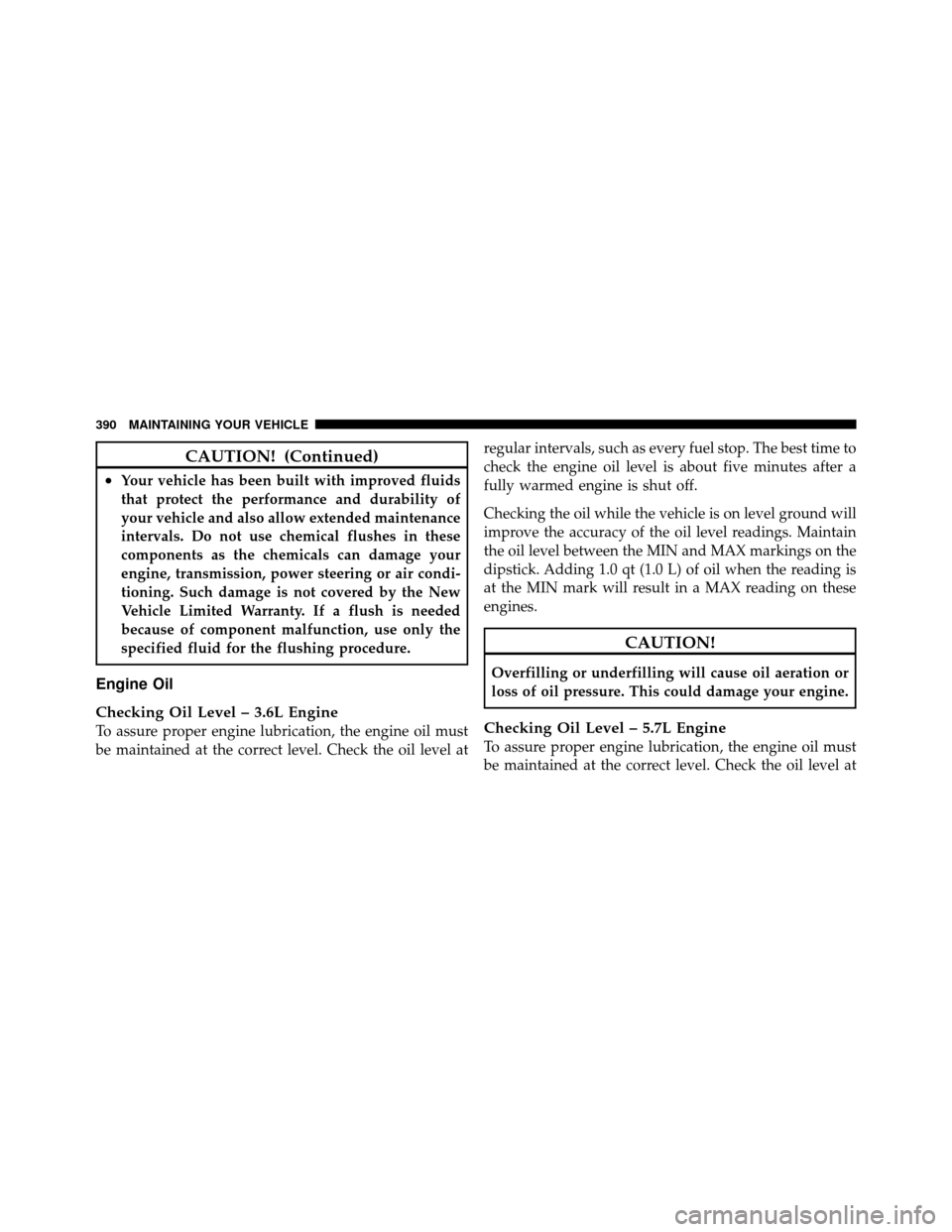
CAUTION! (Continued)
•Your vehicle has been built with improved fluids
that protect the performance and durability of
your vehicle and also allow extended maintenance
intervals. Do not use chemical flushes in these
components as the chemicals can damage your
engine, transmission, power steering or air condi-
tioning. Such damage is not covered by the New
Vehicle Limited Warranty. If a flush is needed
because of component malfunction, use only the
specified fluid for the flushing procedure.
Engine Oil
Checking Oil Level – 3.6L Engine
To assure proper engine lubrication, the engine oil must
be maintained at the correct level. Check the oil level atregular intervals, such as every fuel stop. The best time to
check the engine oil level is about five minutes after a
fully warmed engine is shut off.
Checking the oil while the vehicle is on level ground will
improve the accuracy of the oil level readings. Maintain
the oil level between the MIN and MAX markings on the
dipstick. Adding 1.0 qt (1.0 L) of oil when the reading is
at the MIN mark will result in a MAX reading on these
engines.
CAUTION!
Overfilling or underfilling will cause oil aeration or
loss of oil pressure. This could damage your engine.
Checking Oil Level – 5.7L Engine
To assure proper engine lubrication, the engine oil must
be maintained at the correct level. Check the oil level at
390 MAINTAINING YOUR VEHICLE
Page 393 of 490
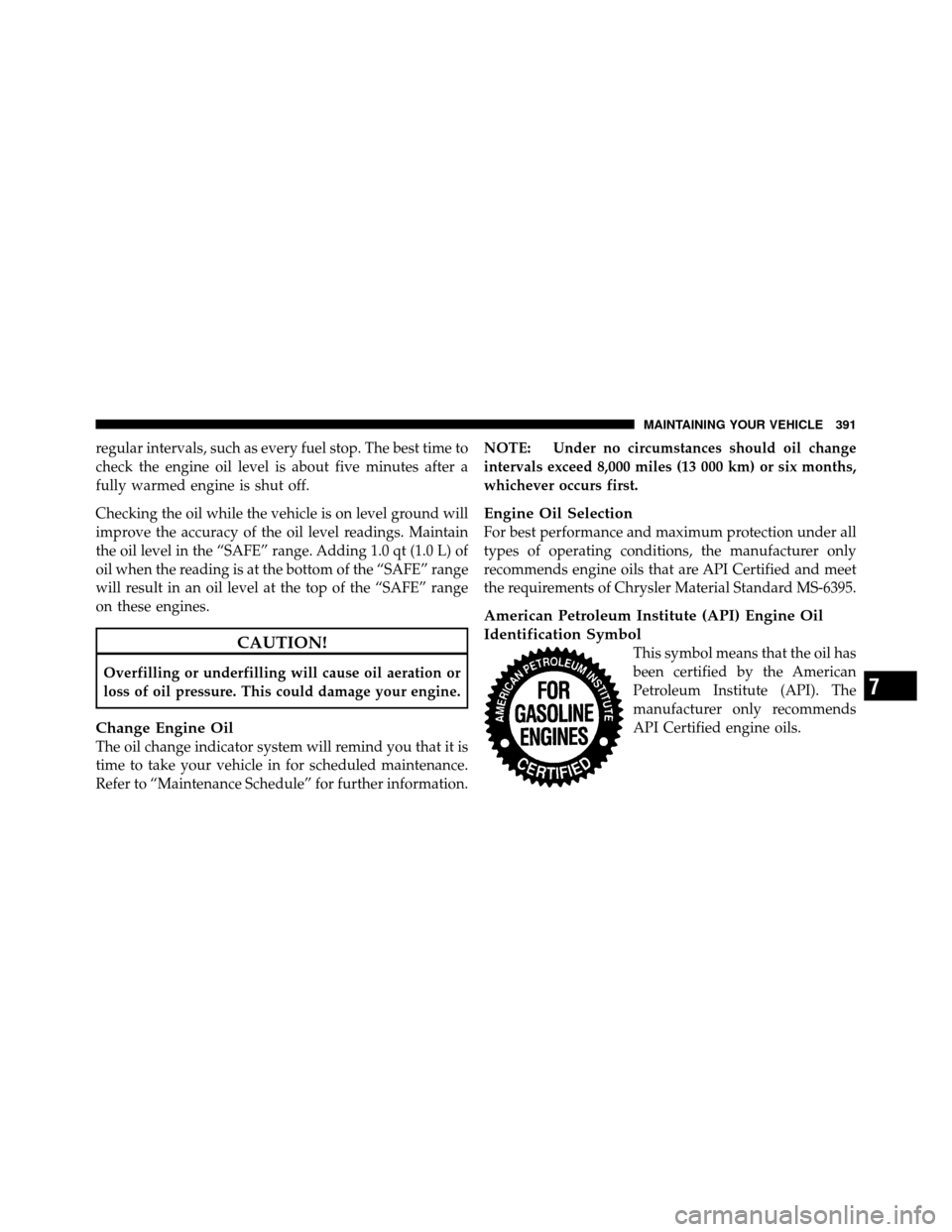
regular intervals, such as every fuel stop. The best time to
check the engine oil level is about five minutes after a
fully warmed engine is shut off.
Checking the oil while the vehicle is on level ground will
improve the accuracy of the oil level readings. Maintain
the oil level in the “SAFE” range. Adding 1.0 qt (1.0 L) of
oil when the reading is at the bottom of the “SAFE” range
will result in an oil level at the top of the “SAFE” range
on these engines.
CAUTION!
Overfilling or underfilling will cause oil aeration or
loss of oil pressure. This could damage your engine.
Change Engine Oil
The oil change indicator system will remind you that it is
time to take your vehicle in for scheduled maintenance.
Refer to “Maintenance Schedule” for further information.NOTE: Under no circumstances should oil change
intervals exceed 8,000 miles (13 000 km) or six months,
whichever occurs first.
Engine Oil Selection
For best performance and maximum protection under all
types of operating conditions, the manufacturer only
recommends engine oils that are API Certified and meet
the requirements of Chrysler Material Standard MS-6395.
American Petroleum Institute (API) Engine Oil
Identification Symbol
This symbol means that the oil has
been certified by the American
Petroleum Institute (API). The
manufacturer only recommends
API Certified engine oils.
7
MAINTAINING YOUR VEHICLE 391
Page 468 of 490
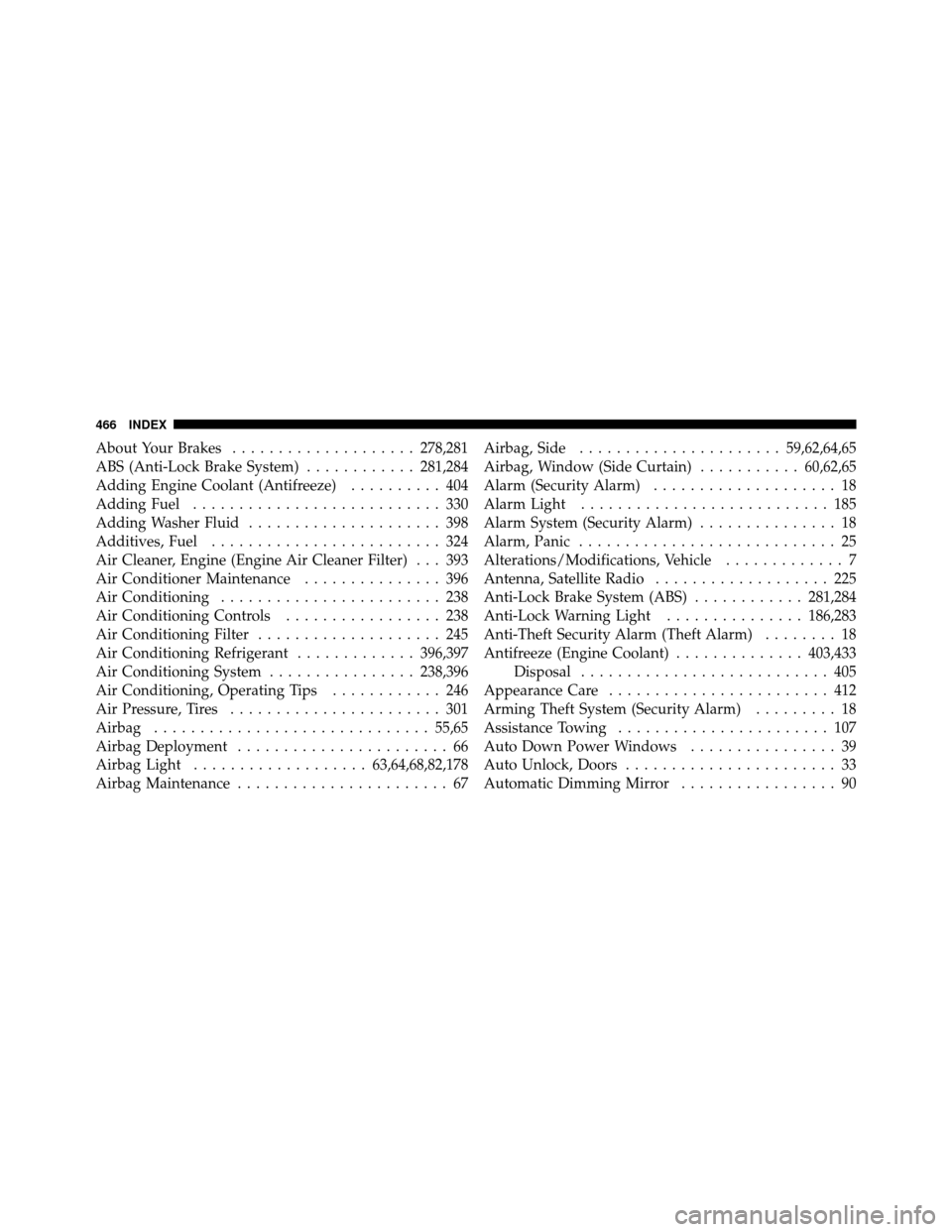
About Your Brakes.................... 278,281
ABS (Anti-Lock Brake System) ............281,284
Adding Engine Coolant (Antifreeze) .......... 404
Adding Fuel ........................... 330
Adding Washer Fluid ..................... 398
Additives, Fuel ......................... 324
Air Cleaner, Engine (Engine Air Cleaner Filter) . . . 393
Air Conditioner Maintenance ............... 396
Air Conditioning ........................ 238
Air Conditioning Controls ................. 238
Air Conditioning Filter .................... 245
Air Conditioning Refrigerant .............396,397
Air Conditioning System ................238,396
Air Conditioning, Operating Tips ............ 246
Air Pressure, Tires ....................... 301
Airbag .............................. 55,65
Airbag Deployment ....................... 66
Airbag Light ................... 63,64,68,82,178
Airbag Maintenance ....................... 67 Airbag, Side
...................... 59,62,64,65
Airbag, Window (Side Curtain) ...........60,62,65
Alarm (Security Alarm) .................... 18
Alarm Light ........................... 185
Alarm System (Security Alarm) ............... 18
Alarm, Panic ............................ 25
Alterations/Modifications, Vehicle ............. 7
Antenna, Satellite Radio ................... 225
Anti-Lock Brake System (ABS) ............281,284
Anti-Lock Warning Light ...............186,283
Anti-Theft Security Alarm (Theft Alarm) ........ 18
Antifreeze (Engine Coolant) ..............403,433
Disposal ........................... 405
Appearance Care ........................ 412
Arming Theft System (Security Alarm) ......... 18
Assistance Towing ....................... 107
Auto Down Power Windows ................ 39
Auto Unlock, Doors ....................... 33
Automatic Dimming Mirror ................. 90
466 INDEX
Page 470 of 490
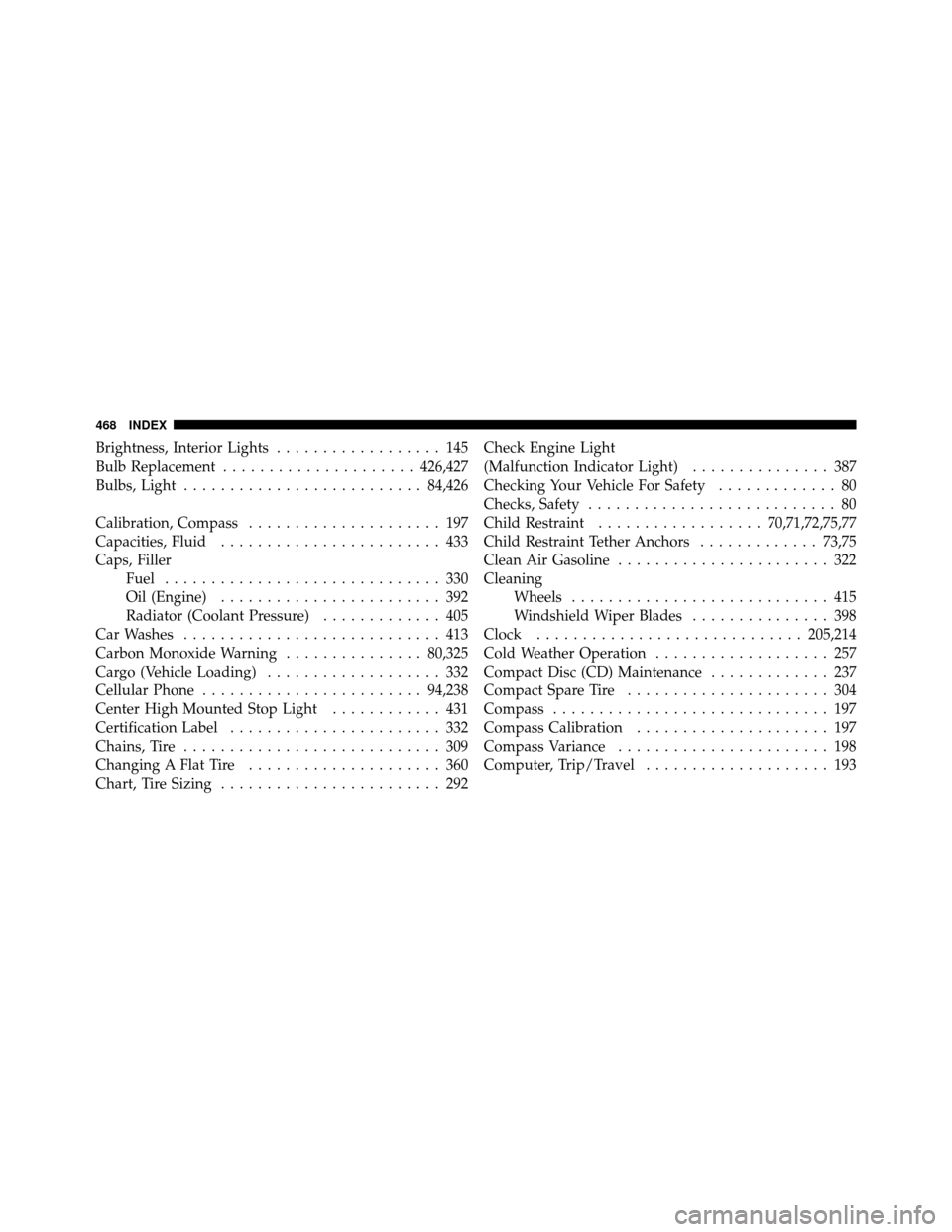
Brightness, Interior Lights.................. 145
Bulb Replacement ..................... 426,427
Bulbs, Light .......................... 84,426
Calibration, Compass ..................... 197
Capacities, Fluid ........................ 433
Caps, Filler Fuel .............................. 330
Oil (Engine) ........................ 392
Radiator (Coolant Pressure) ............. 405
Car Washes ............................ 413
Carbon Monoxide Warning ...............80,325
Cargo (Vehicle Loading) ................... 332
Cellular Phone ........................ 94,238
Center High Mounted Stop Light ............ 431
Certification Label ....................... 332
Chains, Tire ............................ 309
Changing A Flat Tire ..................... 360
Chart, Tire Sizing ........................ 292 Check Engine Light
(Malfunction Indicator Light)
............... 387
Checking Your Vehicle For Safety ............. 80
Checks, Safety ........................... 80
Child Restraint .................. 70,71,72,75,77
Child Restraint Tether Anchors .............73,75
Clean Air Gasoline ....................... 322
Cleaning Wheels ............................ 415
Windshield Wiper Blades ............... 398
Clock ............................. 205,214
Cold Weather Operation ................... 257
Compact Disc (CD) Maintenance ............. 237
Compact Spare Tire ...................... 304
Compass .............................. 197
Compass Calibration ..................... 197
Compass Variance ....................... 198
Computer, Trip/Travel .................... 193
468 INDEX
Page 471 of 490
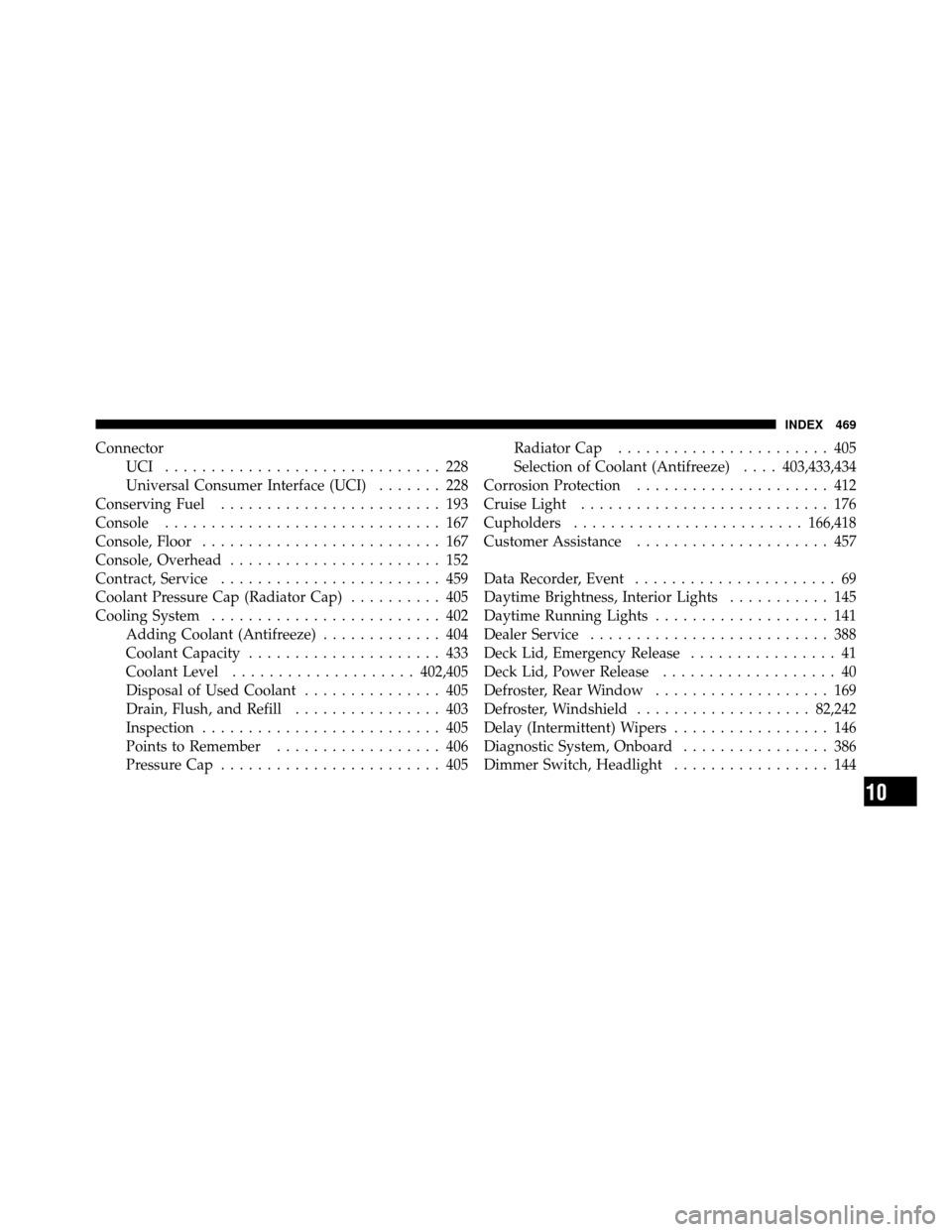
ConnectorUCI .............................. 228
Universal Consumer Interface (UCI) ....... 228
Conserving Fuel ........................ 193
Console .............................. 167
Console, Floor .......................... 167
Console, Overhead ....................... 152
Contract, Service ........................ 459
Coolant Pressure Cap (Radiator Cap) .......... 405
Cooling System ......................... 402
Adding Coolant (Antifreeze) ............. 404
Coolant Capacity ..................... 433
Coolant Level .................... 402,405
Disposal of Used Coolant ............... 405
Drain, Flush, and Refill ................ 403
Inspection .......................... 405
Points to Remember .................. 406
Pressure Cap ........................ 405 Radiator Cap
....................... 405
Selection of Coolant (Antifreeze) ....403,433,434
Corrosion Protection ..................... 412
Cruise Light ........................... 176
Cupholders ......................... 166,418
Customer Assistance ..................... 457
Data Recorder, Event ...................... 69
Daytime Brightness, Interior Lights ........... 145
Daytime Running Lights ................... 141
Dealer Service .......................... 388
Deck Lid, Emergency Release ................ 41
Deck Lid, Power Release ................... 40
Defroster, Rear Window ................... 169
Defroster, Windshield ................... 82,242
Delay (Intermittent) Wipers ................. 146
Diagnostic System, Onboard ................ 386
Dimmer Switch, Headlight ................. 144
10
INDEX 469